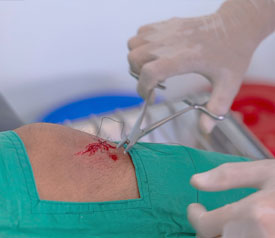
Wound healing is a long process that requires careful attention to care. If the healing process doesn’t go smoothly, a patient can end up with an infection, a serious scar, or other complications.
Wound healing involves four primary stages: hemostasis, inflammation, proliferation, and maturation. Each step is important and patients need to care for their wounds properly along the way.
The most important thing a patient can do during the wound healing process is protect their wound with a proper bandage, secured with a strong adhesive. Tapes like Hy-Tape offer a waterproof seal, easy flexibility, a strong hold, and irritation-free removal. All these features go a long way in helping the skin to heal properly.
Below is a detailed summary of the four stages of the wound-healing process:
Hemostasis Stage
When a wound opens, blood is the very first line of defense to keep the body safe from the infiltration of germs. During the hemostasis stage of wound healing, the body’s main goal is to stop the bleeding.
During hemostasis, the body narrows the nearby blood vessels to help begin the healing process, reducing blood loss. Blood platelets will also stick together and seal up the breaks in the blood vessel walls. They work with collagen and thrombin to thicken the blood and make it harder for it to leave the body.
This stage of wound healing is when the wound is at its most vulnerable to damage and reopening. It’s vital to protect the wound with a clean bandage, sealed with a high-quality, skin-sensitive adhesive like Hy-Tape.
Inflammatory Stage
The inflammatory stage of wound healing involves the body removing debris and bacteria that could be harmful if taken in through the skin. White blood cells flood to the site of the wound to attack any germs that may try to enter the body. After a few days of keeping germs at bay, the white blood cells are replaced with macrophage cells that continue to clean up the wound. These cells also send signals to the immune system to assist in the healing of the wound.
At this point, a lot is going on near the wound and symptoms such as soreness and redness will arise. Protecting the wound with a proper dressing and a tight-holding adhesive is crucial. It’s also important that the adhesive tape used does not cause allergic reactions, and Hy-Tape is designed without common chemicals that could cause skin irritation. With the right bandage and secure tape, the body can do the healing work it needs to do.
Proliferative Stage
Now that the base-level healing has been done, the body can begin working on rebuilding the skin in the proliferative stage of healing. The wound will fill with new cells that will be used to develop new skin tissue. New blood vessels are also developed so the skin can receive blood, oxygen, and nutrients. The skin is now strong enough that the tissue can pull the wound edges together to seal the opening properly. Finally, the beginnings of a new layer of skin cells begin to form on top of the wound.
As with every other stage, a proper bandage secured with Hy-Tape is vital to proliferation. Keeping the wound clean and hydrated is essential, and Hy-Tape provides a waterproof seal that keeps water and debris from infiltrating underneath the bandage.
Maturation Stage
The final stage of wound healing is maturation. In this stage, the body strengthens the repaired skin in a variety of ways. Old skin cells form a scab that can fall off or peel away over time. Cross-linking occurs, strengthening the new tissue and thinning out the scar at the wound site. Depending on the severity of the wound, maturation may be complete in a few weeks to a few years.
At this point, bandaging the wound is less of a necessity but patients should be careful with their skin, especially if they choose not to cover it with a bandage.
How Hy-Tape Keeps Wound Heating On Track
Hy-Tape is designed to help aid the wound healing process in several ways. Wound bandages typically need to be kept safe from external infiltration and Hy-Tape provides a waterproof seal. Wound dressings will be changed periodically and Hy-Tape offers a tight hold that easily peels away thanks to the zinc oxide in the adhesive. Bandages may limit flexibility and Hy-Tape allows patients more movement without the risk of the tape peeling away.
Whether for yourself or your patients, consider Hy-Tape as your go-to choice for wound dressing tape. Contact us now to discuss your needs or place an order here

